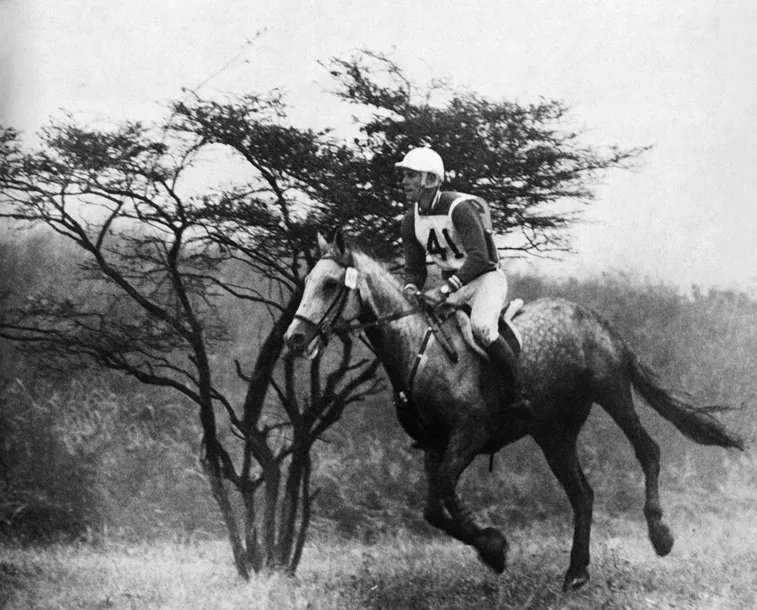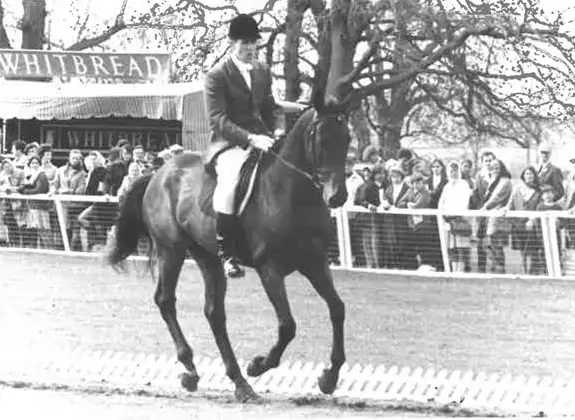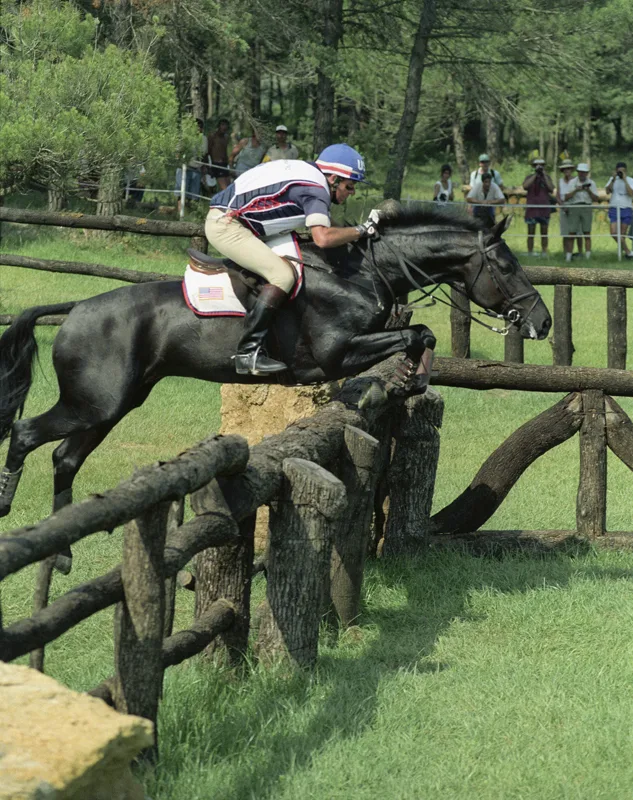J. Michael Plumb has attended a record eight Olympic Games—including the 1980 Alternate Olympics—more than any other U.S. athlete. Here’s a look back at each of them.
1960: Young And Unprepared
Fresh off a team gold and individual silver from the 1959 Pan American Games in Chicago, J. Michael Plumb earned his first Olympic berth in 1960 alongside Michael Page, David Lurie and Walter Staley.
“I didn’t have a clue as to what I was doing,” Plumb recalled, joking that his place on the team headed to Rome had more to do with the slim pickings available rather than his extraordinary talent. Plumb, 20, had never been out of the country before heading to the eventing competition in Pratoni del Vivaro.
“There [were] some hellish looking jumps there, one of which was a concrete jump at the end of the course where Bill Roycroft broke his collarbone and competed in the show jumping the next day,” said Plumb, who also suffered a broken collarbone. He rode his Pan American Games partner Markham, a 7-year-old gelding Plumb’s father had foxhunted.

Mike Plumb made his Olympic debut at the 1960 Rome Olympic Games on Markham, a former foxhunter and equitation horse, and they finished as the best-placed U.S. pair in 15th. Split Seconds/Alamy Stock Photo
“He was black and beautiful,” Plumb said. “[He went] from the equitation and the hunt field to the Olympic Games, which is ridiculous now that I think about it.”
Lurie and Staley both failed to finish on endurance day, and Plumb completed the course—albeit with a fall—and ended up the best U.S. finisher in 15th place.
1964: Plan B, Then Plan C
On Sept. 30, 1964, 11 U.S. Olympic team horses loaded up on an airplane in Newark, New Jersey, leaving the ground just before noon. The group included Markham, headed for his second Games with Plumb.
“He’d had some rough rides in the trailer prior to that,” Plumb remembered. “When I say rough rides, he’d fallen down and lost his confidence while he was being shipped.”
An hour into the flight, Markham began scrambling in his stall.
“There was [team veterinarian] Joe O’Dea and [show jumping coach] Bert de Némethy trying to climb all over this horse to keep him in the box, so he didn’t get into somebody else’s box, and finally he blew a hole in the side of the plane,” Plumb said.
Though they’d tried everything from blindfolds to sedation, once Markham damaged the plane, they had no choice but to euthanize the gelding, and they made an emergency stop in Chicago.
Plumb’s alternate horse Royal Beaver was on the flight, but he wasn’t too excited about that option.
“Royal Beaver was a really bad jumper,” Plumb said. “He would hang his legs; you wouldn’t believe how he could hang his legs. He tried, the poor thing, but he was going to hurt somebody, and he was not going to be any help to our team.”
That’s when Bill Haggard, Plumb’s teammate in ’59 and ’63, offered to send Bold Minstrel to Tokyo. In addition to eventing, Haggard foxhunted and competed in hunter classes on the elegant gray.

Mike Plumb catch rode Bold Minstrel to team silver at the 1964 Tokyo Olympic Games. Photo Courtesy Of FEI
“Holy cow, what a treat,” Plumb said. “One of the best horses in the world then, and then became an even better horse.”
By the time Bold Minstrel arrived, Plumb didn’t have long to get to know the gelding affectionately called “Fatty” for his hunter physique.
“It was probably good because he knew what he was doing, and probably if I had any practice on him I’d just screw him up in a heartbeat,” Plumb said. “He just huntered around the cross-country course and jumped the hell out of the stadium fences.”
Plumb was grateful for the opportunity that led to a team silver (alongside Michael Page/The Grasshopper, Lana DuPont/Mr. Wister and Kevin Freeman/Gallopade).
“[Haggard] was in line to make the team, didn’t make the team, and was such a wonderful person—courageous and brave—to loan me his horse,” Plumb said. “How good is that? That was just overwhelming. [Bold Minstrel] then of course did what he did, which was go to Bill Steinkraus and jumped the highest jump in Madison Square Garden and did all kinds of good things. [Haggard] was a great sportsman, and I owe that Games to that man.”
1968: Invisible Jumps And A Monsoon
Heavy rain soaked the 1968 Olympic Games in Mexico City. As endurance day progressed, conditions deteriorated so much that jumps were underwater, with just the tops of the flags indicating the location of the obstacles. By the time the final third of the contestants left the start box, horses were being pulled downstream by the current. Organizers moved flags further downstream where they hoped the current was weaker and put up bushes to show where the flooded bank was.
ADVERTISEMENT

Mike Plumb and Plain Sailing competed at Badminton en route to making the 1968 Olympic team, which would win a silver medal. Photo Courtesy Of The USET Archives
“[Kevin Freeman] dragged horses out of the ditches on the cross-country because there was a monsoon, and there was a lot of trouble,” Plumb recalled. “I fell at one of my water jumps where all you could see were flags. The water was so high you couldn’t see the jump. It was a mess—Mexico was a mess, but we won a silver medal in spite of that.”
1972: Entering A New Era
By 1972 the U.S. team was entering a new era. After a rotating group of coaches, Jack Le Goff took over the position in 1970 and would stay through the 1984 Olympics. Under his keen eye, the ragtag group of riders became a cohesive unit, according to Plumb.
“We really didn’t know what we were doing,” Plumb said. “We’d been to a lot of these Olympics, and I was a bit arrogant. Jack criticized me, and I’ll tell you, [I’d say] I’d already been to a bunch of Olympics [and I knew what I was doing], and they laughed at me.”
Plumb recalled a scramble to get horses for the 1972 Games in Munich. The team ended up with a familiar group of riders: Freeman on Good Mixture, Davidson now on Plain Sailing, Wofford on Kilkenny, and Plumb rode Free And Easy.

The U.S. team of (from left) Bruce Davidson and Plain Sailing, Jimmy Wofford and Kilkenny, Kevin Freeman and Good Mixture, Chef d’Equipe Jack Le Goff, reserve rider Jim Powers and Foster, and Mike Plumb and Free And Easy earned their third consecutive silver medal in Munich in 1972. Photo Courtesy Of The USET Archives
Plumb and his wife at the time, Donnan Sharp, had purchased the attractive gelding from a hunter dealer, but Plumb had reservations about Free And Easy.
“He had an old bow, and I was taking a real chance in bringing him,” Plumb said. “Lots of times old bows set, and they do pretty well, and he did very well, enough so that I would be picked as a member of the team.”
Cross-country was a big, galloping course and was considered to be the fairest test since civilians were first allowed to participate in the Games in 1952. But Free And Easy fell on course, and though the horse was up so quickly he still earned bonus points for speed, he paid the price when he re-injured his tendon. After icing overnight, Free And Easy had just one rail down in show jumping, helping the team score their third consecutive silver medal.
1976: “It’s A Wonderful Thing”
Heading into the 1976 Montreal Olympic Games, the U.S. eventing team had developed a rhythm after six years under Le Goff, but many of the top horses were out due to injury.
Plumb had two options: Good Mixture, with whom he’d won individual silver and team gold at the ’74 World Championships (England), and a greener 7-year-old by the name of Better And Better, whom Carol Lavell had started as a dressage horse.
“Jack didn’t want me to ride Better And Better, but I did because I trusted him,” said Plumb. “He was young. He wasn’t a very good jumper, but he would try anything. So damn if I didn’t make the right choice because he tried everything, and he almost won it. He’s just a horse full of heart.”

Mike Plumb chose Better And Better for the 1972 Montreal Olympics and earned team gold and individual silver. Karl Leck Photo
The team—Plumb, Tad Coffin (Bally Cor), Davidson (Irish Cap) and Mary Anne Tauskey (Marcus Aurelius)—finally stepped onto the top of the podium, and Coffin won the individual competition, with Plumb just behind him in silver.
“I have to think that the Montreal one was the successful one because I had my choice of two horses, and I chose the one I liked, and he didn’t let me down,” said Plumb. “It wasn’t like it was in the United States, but it was pretty close to the United States, so it felt like a real victory for our team. We’d put in a lot of work with Jack to get better.
“It made you feel like you won something for the United States of America, and standing on the podium, what happens to you—a little something happens to you, and you feel kind of sad and kind of glad and kind of proud,” he continued. “It’s a wonderful thing, and it doesn’t happen very often. That’s how I felt even though I’d been there before in the three prior—I was too young; I didn’t
really know what I was doing.”
1980: Just Happy To Compete
(Alternate Olympics at Fountainebleu)
After the Soviet Union invaded Afghanistan in late 1979, the United States led more than 60 nations in a boycott of the 1980 Olympic Games. Only 11 nations participated in the equestrian sports, and the Fédération Equestre Internationale hosted an Alternate Olympics, with the eventing competition in Fontainebleau, France.
“We did a lot of stuff with Jack in France because he had a lot of connections, and we based there for a while,” Plumb recalled. “He took us to the races, and he introduced us to his friends’ friends. He was a great diplomat and a very good teacher. He’s sorely missed.”
Plumb said the competition was fierce in France. “I would say we were just happy to compete,” he said. “All the good riding countries competed in France. I don’t know how many [top countries] were at Russia; all the big-time ones were at the alternate ones, so we liked that.”
The U.S. team, which included Mike Huber on Gold Chip, Wofford on Carawich and Torrance Watkins on Poltroon, sat second following dressage, and as cross-country progressed they amassed a larger lead. Then Huber’s Gold Chip came in with a cut on her knee that made it unlikely she’d show jump. As the anchor rider, Plumb had to finish to keep the team in it.
Plumb was riding Laurenson, purchased by the Mara family from the Australians after Wayne Roycroft rode him at the Games in Montreal. Plumb described Laurenson as a cool horse. Though the gelding won quite a few horse trials, he wasn’t the most reliable jumper.

When the United States led a 60-plus country boycott of the 1980 Olympic Games in Moscow, the Fédération Equestre Internationale hosted an alternate Olympics, and Mike Plumb was selected with Laurenson for the U.S. team. Kit Houghton Photo
“If he was in an area where he wasn’t so sure he would stop,” said Plumb. “I had a really bad injury—groin injury—before that, and so I never just got right, and he was just a little bit cheap. Put him in a bad place, and he would say no thanks. There was a zigzag jump at that Games; it was a water complex that was pretty straightforward, but he would have none of it. It was about three-quarters through, and I’m not so sure it was his fault, but between the two of us it wasn’t a great show.”
The pair was eliminated, and the U.S. dreams of a team medal were dashed, although Wofford won individual silver with Carawich, and Watkins took bronze aboard Poltroon.
ADVERTISEMENT
1984: Tension And Triumph
The lead-up to the 1984 Olympic Games marked the beginning of the end of Le Goff’s tenure. Following a run at Ledyard Farm International Horse Trials (Massachusetts), the riders wanted a change. They felt they needed good gallops and hills in order to be prepared, and the team headquarters at Hamilton Farm in Gladstone, New Jersey, didn’t provide that.
Against the wishes of Le Goff, who resided in Gladstone, the team shipped to Unionville, Pennsylvania, for their final prep work.
“We’re all pretty good friends, and we had to do what we had to do,” Plumb told the Chronicle in 1984. “We came back from a gallop at Hamilton and decided we couldn’t stay—there was no place to do the conditioning. (Insects were also cited as a problem.) We never really sat down and decided to become a team; it just sort of happened after Ledyard.”
But the move caused a rift.
“That was a problem with our team,” Plumb remembered. “We didn’t like to split, but we really needed to go down there to get fit. That hurt Jack’s feelings. We all met in Los Angeles.”
The Santa Anita racetrack hosted the Olympic dressage and show jumping, but the cross-country took place two hours away at Fairbanks Ranch near San Diego. Due to the travel time, the competition was spread out over six days, with rest days on either side of cross-country.

Mike Plumb said Blue Stone, his 1984 team gold-medal partner, was a “horse that could jump anything.” Chronicle Archives Photo
Aboard Blue Stone, Plumb was team trailblazer, and his information about the slippery course proved crucial to the team, as most accidents were happening on the flat.
“He was a quiet warrior,” Plumb said of Blue Stone. “He was Irish. He wasn’t a terribly good mover, but he was a very good jumper. He had a lot of prizes; he won a lot of things. Jimmy rode him for a while, and then I got the ride on him in ’84. I remember that he was first to go on the team because we needed a horse that we thought was going to get around. There were some banks there that were pretty hairy looking, and the water was too. He went around, and it was under the time, but that was our plan for the course, so then everyone else ran the course fine. He was a horse that could jump anything.”
In front of a home crowd, the U.S. team of Plumb, Davidson on J.J. Babu, Karen Stives on Ben Arthur and Torrance Fleischmann (now Watkins) on Finvarra watched as the American flag was hoisted into the air, gold medals hanging around their necks. Stives also earned individual silver with Ben Arthur, but Plumb said the disagreement with Le Goff left a sour taste in his mouth.
“It was after that that [Le Goff] decided for one reason or another that he didn’t want to do it anymore,” Plumb said. “The team became something else and various other coaches. When he left we kind of lost our initiative to be a team, and nobody could do it the way he could because he wanted everybody there. He could ride everybody else’s horses. He could do all the things we were supposed to
do and do them better than we could. He was my idea of a coach’s coach, just the best possible.”
1992: A Rush Job
Without a suitable mount in 1988, Plumb was left off his first Olympic team since 1960, but four years later he was back to compete in Barcelona with Adonis, owned by Michael Friedlander. Though the black gelding had good finishes in his prep runs, Plumb admits that the whole process felt rushed since the owners were eager to have an Olympic horse. But he lays as much blame on himself.
“I didn’t give him the best ride,” he said. “He could’ve been a better horse if I’d had a little more time.”
Plumb’s teammates—Stephen Bradley, Todd Trewin and Jil Walton—were young, and he was considered a mentor for the team.
“I was the only one who had some mileage,” he said.
Due to the terrain and high heat, the endurance phases were shortened and time limits extended in order to allow horses to recover before cross-country, but even with those concessions, several horses had heat distress and other difficulties.
Plumb was first to go and fell. He then was held for 40 minutes while a Russian horse was extricated from a fence. They finished, but the effort left him and the team well off the podium.
This article ran in the July 2020 Olympic Overview Issue of The Chronicle of the Horse.
Subscribers may choose online access to a digital version or a print subscription or both, and they will also receive our lifestyle publication, Untacked. Or you can purchase a single issue or subscribe on a mobile device through our app The Chronicle of the Horse LLC.
If you’re just following COTH online, you’re missing so much great unique content. Each print issue of the Chronicle is full of in-depth competition news, fascinating features, probing looks at issues within the sports of hunter/jumper, eventing and dressage, and stunning photography.
What are you missing if you don’t subscribe?















